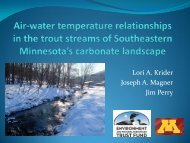Great Lakes Regional Water Program Great Lakes Regional Water
Great Lakes Regional Water Program Great Lakes Regional Water
Great Lakes Regional Water Program Great Lakes Regional Water
Create successful ePaper yourself
Turn your PDF publications into a flip-book with our unique Google optimized e-Paper software.
<strong>Regional</strong> Coordination Impacts<br />
Overall, the GLRWP has:<br />
7<br />
7<br />
7<br />
7<br />
Increased communication and networking among CSREES State <strong>Water</strong> Quality Coordinators, Land and Sea Grant<br />
institutions, 1994 Tribal Colleges, <strong>Water</strong> Resource Research Institutes (WRRIs), and federal and state agencies<br />
within the North Central Region and USEPA’s Region 5.<br />
Increased awareness of the <strong>Great</strong> <strong>Lakes</strong> <strong>Regional</strong> <strong>Program</strong> among Land and Sea Grant Institutions, 1994 Tribal<br />
Colleges, WRRIs, and federal and state agencies within the North Central Region and USEPA’s Region 5.<br />
Elevated the visibility of collaborative multi-state approaches to addressing water quality issues, paving the way<br />
for others to consider similar efforts. Within Extension’s North Central Region, The <strong>Great</strong> <strong>Lakes</strong> <strong>Regional</strong> <strong>Water</strong><br />
<strong>Program</strong> is often cited as an example of how to implement a multi-state land grant program.<br />
Increased documentation of <strong>Regional</strong> and National <strong>Water</strong> <strong>Program</strong> projects and success stories through development,<br />
utilization and maintenance of a national reporting system.<br />
The <strong>Great</strong> <strong>Lakes</strong> <strong>Regional</strong> program has leveraged over $8 million (more than a 3:1 ratio) since its inception in 2000, benefiting<br />
water quality research and outreach efforts and participating agencies and organizations, as well as building the<br />
visibility and reputation of CSREES as a productive and contributing partner.<br />
Selected Coordination Activities:<br />
7<br />
7<br />
7<br />
With USEPA, the GLRWP designed and facilitated a regional working session titled, “Multi-State<br />
Collaborative Approaches to <strong>Water</strong> Quality Improvement: Creating Mass and Momentum in the Midwest.”<br />
The purpose of this working session was to bring professionals together around each of the GLRWP’s six<br />
priority Themes to agree upon priority issues within each and action items to address these issues. More than<br />
80 people from Land and Sea Grant universities and colleges, state environmental agencies, federal agencies,<br />
non-profit organizations, and other water quality-related organizations attended, and approaches (in the form<br />
of logic models) were developed for most of the identified priority issues in each Theme. Please see the<br />
Collaboration Success Story on page 7 for more details.<br />
The <strong>Regional</strong> <strong>Program</strong> continues to coordinate with the Agriculture Drainage Management Task Force. The<br />
Task Force is a partnership of ARS, NRCS, CSREES and Land Grant University researchers that focuses<br />
attention on new management practices that can mitigate the negative impact of drainage. The Task Force serves<br />
the function of an advisory group to the <strong>Regional</strong> Team.<br />
The <strong>Great</strong> <strong>Lakes</strong> <strong>Regional</strong> Leadership Team, coordinated participation of the Land Grant Universities in a USEPA<br />
regional training: Technical Fundamentals of Concentrated Animal Feeding Operations (CAFOs) for Permit<br />
Writers and Inspectors. The Team has also been working with USEPA Region 5 on determining needs for<br />
follow-up trainings for each state related to CAFOs.<br />
5

















